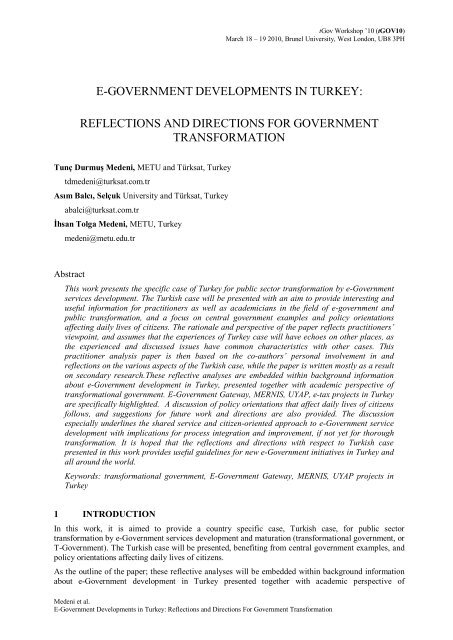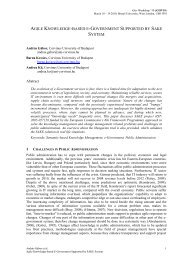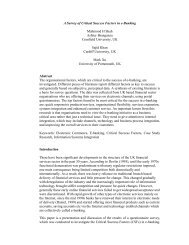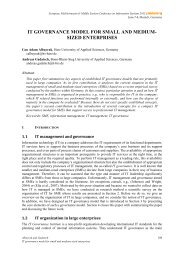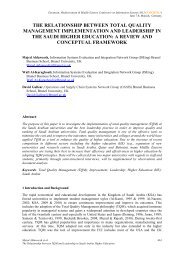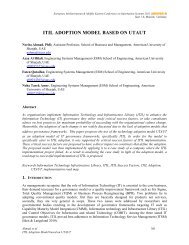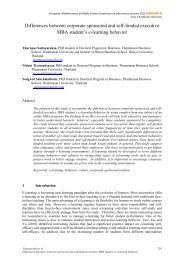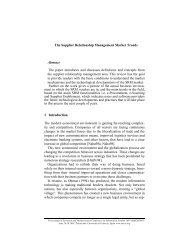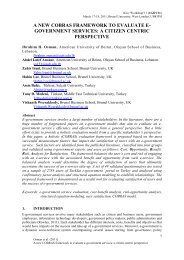e-government developments in turkey: reflections and ... - ISEing
e-government developments in turkey: reflections and ... - ISEing
e-government developments in turkey: reflections and ... - ISEing
You also want an ePaper? Increase the reach of your titles
YUMPU automatically turns print PDFs into web optimized ePapers that Google loves.
tGov Workshop ‟10 (tGOV10)<br />
March 18 – 19 2010, Brunel University, West London, UB8 3PH<br />
E-GOVERNMENT DEVELOPMENTS IN TURKEY:<br />
REFLECTIONS AND DIRECTIONS FOR GOVERNMENT<br />
TRANSFORMATION<br />
Tunç Durmuş Medeni, METU <strong>and</strong> Türksat, Turkey<br />
tdmedeni@turksat.com.tr<br />
Asım Balcı, Selçuk University <strong>and</strong> Türksat, Turkey<br />
abalci@turksat.com.tr<br />
İhsan Tolga Medeni, METU, Turkey<br />
medeni@metu.edu.tr<br />
Abstract<br />
This work presents the specific case of Turkey for public sector transformation by e-Government<br />
services development. The Turkish case will be presented with an aim to provide <strong>in</strong>terest<strong>in</strong>g <strong>and</strong><br />
useful <strong>in</strong>formation for practitioners as well as academicians <strong>in</strong> the field of e-<strong>government</strong> <strong>and</strong><br />
public transformation, <strong>and</strong> a focus on central <strong>government</strong> examples <strong>and</strong> policy orientations<br />
affect<strong>in</strong>g daily lives of citizens. The rationale <strong>and</strong> perspective of the paper reflects practitioners’<br />
viewpo<strong>in</strong>t, <strong>and</strong> assumes that the experiences of Turkey case will have echoes on other places, as<br />
the experienced <strong>and</strong> discussed issues have common characteristics with other cases. This<br />
practitioner analysis paper is then based on the co-authors’ personal <strong>in</strong>volvement <strong>in</strong> <strong>and</strong><br />
<strong>reflections</strong> on the various aspects of the Turkish case, while the paper is written mostly as a result<br />
on secondary research.These reflective analyses are embedded with<strong>in</strong> background <strong>in</strong>formation<br />
about e-Government development <strong>in</strong> Turkey, presented together with academic perspective of<br />
transformational <strong>government</strong>. E-Government Gateway, MERNIS, UYAP, e-tax projects <strong>in</strong> Turkey<br />
are specifically highlighted. A discussion of policy orientations that affect daily lives of citizens<br />
follows, <strong>and</strong> suggestions for future work <strong>and</strong> directions are also provided. The discussion<br />
especially underl<strong>in</strong>es the shared service <strong>and</strong> citizen-oriented approach to e-Government service<br />
development with implications for process <strong>in</strong>tegration <strong>and</strong> improvement, if not yet for thorough<br />
transformation. It is hoped that the <strong>reflections</strong> <strong>and</strong> directions with respect to Turkish case<br />
presented <strong>in</strong> this work provides useful guidel<strong>in</strong>es for new e-Government <strong>in</strong>itiatives <strong>in</strong> Turkey <strong>and</strong><br />
all around the world.<br />
Keywords: transformational <strong>government</strong>, E-Government Gateway, MERNIS, UYAP projects <strong>in</strong><br />
Turkey<br />
1 INTRODUCTION<br />
In this work, it is aimed to provide a country specific case, Turkish case, for public sector<br />
transformation by e-Government services development <strong>and</strong> maturation (transformational <strong>government</strong>, or<br />
T-Government). The Turkish case will be presented, benefit<strong>in</strong>g from central <strong>government</strong> examples, <strong>and</strong><br />
policy orientations affect<strong>in</strong>g daily lives of citizens.<br />
As the outl<strong>in</strong>e of the paper; these reflective analyses will be embedded with<strong>in</strong> background <strong>in</strong>formation<br />
about e-Government development <strong>in</strong> Turkey presented together with academic perspective of<br />
Medeni et al.<br />
E-Government Developments <strong>in</strong> Turkey: Reflections <strong>and</strong> Directions For Government Transformation
tGov Workshop ‟10 (tGOV10)<br />
March 18 – 19 2010, Brunel University, West London, UB8 3PH<br />
transformational <strong>government</strong>. E-Government Gateway, MERNIS, UYAP projects <strong>in</strong> Turkey will be<br />
specifically emphasized. A discussion of policy orientations that affect daily lives of citizens will<br />
follow, <strong>and</strong> suggestions for future work <strong>and</strong> directions will also be provided.<br />
As hoped by the co-authors, the result<strong>in</strong>g work provides a good, reflective documentation of the recent<br />
e-<strong>government</strong> <strong>developments</strong> towards public transformation <strong>in</strong> Turkey. It is also hoped that the<br />
<strong>reflections</strong> <strong>and</strong> directions with respect to Turkish case presented <strong>in</strong> this work will provide useful<br />
guidel<strong>in</strong>es for new e-Government <strong>in</strong>itiatives all around the world.<br />
1.1 Research Methodology<br />
The paper presents practitioners‟ viewpo<strong>in</strong>t that is based on the authors‟ personal <strong>in</strong>volvement <strong>in</strong> <strong>and</strong><br />
<strong>reflections</strong> on the various aspects of the Turkey case. This practitioner analysis paper is then prepared,<br />
ma<strong>in</strong>ly based on secondary research on publicly available <strong>in</strong>formation on the Internet.<br />
2 TRANSFORMATIONAL GOVERNMENT<br />
Evolv<strong>in</strong>g from basic <strong>in</strong>formation provision<strong>in</strong>g towards more <strong>in</strong>tegrated, jo<strong>in</strong>ed up <strong>and</strong> citizen-centric<br />
service offer<strong>in</strong>gs, e-Government services are now work<strong>in</strong>g towards realis<strong>in</strong>g T-Government – as the<br />
highest level of maturity for e-Government development. T-<strong>government</strong> redef<strong>in</strong>es the delivery of<br />
<strong>government</strong> services by provid<strong>in</strong>g a s<strong>in</strong>gle po<strong>in</strong>t of contact to citizens‟, mak<strong>in</strong>g the <strong>government</strong><br />
transparent to citizens, bus<strong>in</strong>esses (, <strong>and</strong> state). From a dem<strong>and</strong> perspective, extensive efforts are also<br />
needed to <strong>in</strong>crease citizens‟ awareness about the transformation of the delivery of <strong>government</strong> services.<br />
This awareness could result <strong>in</strong> <strong>in</strong>creased e-participation, as well.<br />
(http://www.ise<strong>in</strong>g.org/tgovwebsite/CFP.pdf) Development of new services <strong>and</strong> improvement of<br />
exist<strong>in</strong>g services may then be an area where citizen dem<strong>and</strong> <strong>and</strong> <strong>government</strong> provision meet.<br />
The research, yet, shows that still the e-<strong>government</strong> <strong>in</strong>itiatives are mostly away from reach<strong>in</strong>g the state<br />
of t-Government. For <strong>in</strong>stance, West (2004) acknowledges that while e-<strong>government</strong> transformation <strong>and</strong><br />
revolution has the possibility to enhance democratic responsiveness <strong>and</strong> boosts beliefs of effective<br />
<strong>government</strong>, it falls short of its potential to transform service delivery <strong>and</strong> public trust <strong>in</strong> <strong>government</strong>.<br />
Torres, P<strong>in</strong>a <strong>and</strong> Royo (2005) also discuss that e-<strong>government</strong> <strong>in</strong>itiatives (at regional <strong>and</strong> local levels <strong>in</strong><br />
EU) still reflect present service delivery patterns, not transform them.<br />
The recent OECD report (2009) then encourages reth<strong>in</strong>k<strong>in</strong>g e-Government services, consider<strong>in</strong>g usercentered<br />
approaches. With<strong>in</strong> these approaches; improv<strong>in</strong>g, monitor<strong>in</strong>g <strong>and</strong> evaluat<strong>in</strong>g user take-up are<br />
especially highlighted, represent<strong>in</strong>g the paradigm shift from <strong>government</strong> centricity to citizen centricity.<br />
Meanwhile UN (2008) underl<strong>in</strong>es <strong>in</strong>creased <strong>in</strong>tegration <strong>in</strong> service delivery based on commonality of<br />
<strong>in</strong>frastructures, data, <strong>and</strong> bus<strong>in</strong>ess processes, <strong>and</strong> service <strong>in</strong>novation achieved by multi-channel service<br />
delivery <strong>and</strong> smaller <strong>and</strong> smarter use of back-end processes <strong>and</strong> systems to support bigger <strong>and</strong> better<br />
front-end operations encourage more collaborative models of service delivery. These models of<br />
“connected or networked <strong>government</strong>” request <strong>government</strong> agencies aga<strong>in</strong> reth<strong>in</strong>k their operations, to<br />
move towards a cha<strong>in</strong>-oriented paradigm with respect to structure, culture, knowledge <strong>and</strong> management,<br />
<strong>and</strong> to look towards technology as a strategic tool <strong>and</strong> an enabler for public service <strong>in</strong>novation <strong>and</strong><br />
productivity growth. (ibid.)<br />
In response to the various highlighted need of reth<strong>in</strong>k<strong>in</strong>g the services of e-Government <strong>and</strong> realis<strong>in</strong>g the<br />
state of t-Government, for <strong>in</strong>stance, Sahraoui, Ghoneim, Irani <strong>and</strong> Özkan (2008) suggests a research<br />
agenda of t-Government for benefit realization. Accord<strong>in</strong>gly, “the ma<strong>in</strong> threads of t-Government<br />
encompass:<br />
A citizen-centric delivery of public services or e-<strong>in</strong>clusion<br />
A shared service culture to maximise value added to clients<br />
The effective delivery <strong>and</strong> management of resources <strong>and</strong> skills with<strong>in</strong> <strong>government</strong> – or professionalism.<br />
Medeni et al.<br />
E-Government Developments <strong>in</strong> Turkey: Reflections <strong>and</strong> Directions For Government Transformation
tGov Workshop ‟10 (tGOV10)<br />
March 18 – 19 2010, Brunel University, West London, UB8 3PH<br />
The research agenda needs to <strong>in</strong>clude the management of change dimension of these phenomena.” (p.<br />
323) The authors (ibid.) then suggest a strategic governance model for transformation <strong>and</strong> benefit<br />
realization.<br />
With<strong>in</strong> such a strategic governance model, issues of change management, process <strong>in</strong>tegration, citizencentric<br />
<strong>in</strong>tegrated delivery, <strong>and</strong> shared service culture as a part of benefit realiz<strong>in</strong>g transformation are<br />
also among the hot topics <strong>in</strong> the Turkish case. This section is then followed by background <strong>in</strong>formation<br />
on the Turkish case <strong>and</strong> specific projects of E-Government Gateway, MERNIS, UYAP that provide a<br />
perspective on these hot topics.<br />
3 E-GOVERNMENT IN TURKEY AND TURKISH CASE OF GOVERNMENT<br />
TRANSFORMATION<br />
Although previous <strong>in</strong>itiatives (such as build<strong>in</strong>g up a central civil registration system) can also be traced<br />
back to the 1970s, <strong>in</strong> Turkey, e-Government <strong>in</strong>itiatives could be said to start <strong>in</strong> 1998 with the<br />
“Kamunet” project that was aimed at establish<strong>in</strong>g a national <strong>in</strong>formation system. Soon after this <strong>in</strong> the<br />
framework or the “e-Europe plus” project Turkey prepared its own action plan named the e-Türkiye<br />
<strong>in</strong>itiative <strong>in</strong> 2001. In 2006 the Information Society Strategy document published by the State Plann<strong>in</strong>g<br />
Organization (Devlet Planlanma Teşkilatı, DPT) cont<strong>in</strong>ued the development of e-Government services<br />
for transform<strong>in</strong>g Turkey <strong>in</strong>to an <strong>in</strong>formation society. (DPT, 2006)<br />
Officially launched <strong>in</strong> December 2008, the E-Government Gateway (EGG) is a major milestone for<br />
transform<strong>in</strong>g <strong>in</strong>to the Information Society for <strong>and</strong> achiev<strong>in</strong>g the related Strategic Goals set by Turkey. It<br />
aims to provide Turkey's 70 million citizens <strong>and</strong> bus<strong>in</strong>ess entities with a s<strong>in</strong>gle po<strong>in</strong>t of access, onestop-shop,<br />
to e-Government services. The implementation process of EGG is based on service<br />
transformation. The ma<strong>in</strong> pr<strong>in</strong>ciple will be the consideration of user satisfaction issues when redesign<strong>in</strong>g<br />
the bus<strong>in</strong>ess processes of public <strong>in</strong>stitutions <strong>and</strong> services delivered to citizens <strong>and</strong> enterprises.<br />
The priority <strong>in</strong> services transformation will not be merely to transfer available bus<strong>in</strong>ess processes to<br />
electronic channels without mak<strong>in</strong>g any improvements; on the contrary, the aim will be to deliver these<br />
electronic <strong>government</strong> services, as processes which are redesigned accord<strong>in</strong>g to user needs for<br />
<strong>in</strong>tegration or simplification when necessary, <strong>in</strong> an effective, un<strong>in</strong>terrupted, fast, transparent, reliable<br />
way.<br />
There are currently more than 150 e-services <strong>in</strong>tegrated <strong>in</strong>to EGG <strong>and</strong> new services are under<br />
development. Selected e-services are presented <strong>in</strong> Table1. Besides these services, EGG provides l<strong>in</strong>ks to<br />
hundreds of electronic services provided by <strong>in</strong>dividual agencies from their own websites. Currently<br />
EGG services do not “take over” agency web site services, however it provides a trustworthy, userfriendly<br />
choice with a s<strong>in</strong>gle sign-up mechanism to securely access all services <strong>in</strong> one place. Identity<br />
management us<strong>in</strong>g personal password <strong>and</strong> e-signature are <strong>in</strong>tegrated <strong>in</strong>to the system, <strong>and</strong> limited<br />
f<strong>in</strong>ancial transactions <strong>and</strong> higher levels of personalization are planned for the near future.<br />
Organization <strong>and</strong> Name of Service<br />
BİMER- Prime M<strong>in</strong>istry Communication<br />
Center New Application<br />
M<strong>in</strong>istry of Justice Court Case File<br />
Inquiry<br />
M<strong>in</strong>istry of National Defense- Logistics<br />
Mobilization Data for Work Mach<strong>in</strong>ery<br />
M<strong>in</strong>istry of F<strong>in</strong>ance e-Payroll Service<br />
Explanation<br />
With this service, citizens can send their requests,<br />
compla<strong>in</strong>ts, op<strong>in</strong>ions, suggestions <strong>and</strong> <strong>in</strong>formation.<br />
Through this service, citizens may list any lawsuits filed<br />
about them <strong>in</strong> national courts <strong>and</strong> may monitor their<br />
details.<br />
This is a service by which you can <strong>in</strong>quire whether or not<br />
work mach<strong>in</strong>ery has Mobilization Duty Order.<br />
This is a service whereby the citizens can list their<br />
Medeni et al.<br />
E-Government Developments <strong>in</strong> Turkey: Reflections <strong>and</strong> Directions For Government Transformation
tGov Workshop ‟10 (tGOV10)<br />
March 18 – 19 2010, Brunel University, West London, UB8 3PH<br />
M<strong>in</strong>istry of Internal Affairs e-Internal<br />
Affairs Project Document Follow up<br />
General Directorate of Police- Driver‟s<br />
License Penalty Po<strong>in</strong>ts Inquiry<br />
M<strong>in</strong>istry of National Education- MEB<br />
Exam<strong>in</strong>ation Results Inquiry<br />
M<strong>in</strong>istry of Industry <strong>and</strong> Trade- Operation<br />
Manual Inquiry<br />
Undersecretariat of Shipp<strong>in</strong>g -<br />
International Oil Pollution Prevention<br />
Certificate<br />
Social Security Agency- SGK Registry<br />
Inquiry<br />
İŞKUR- Unemployment Compensation<br />
Application<br />
PTT- Registered Mail Follow up<br />
General Directorate of Civil Aviation-<br />
Flight Crew Licens<strong>in</strong>g/Rat<strong>in</strong>g Application<br />
TCDD- e-Ticket Reservation <strong>and</strong> Sales<br />
DMİGM- Daily Weather Forecast<br />
Inl<strong>and</strong> Revenue Service - e-Tax Sign<br />
Inquiry<br />
TCMB- Exchange Rates<br />
KOSGEB- Bus<strong>in</strong>ess Status Inquiry<br />
payrolls <strong>and</strong> <strong>in</strong>quire about the details of their payrolls.<br />
With this service, the user may <strong>in</strong>quire about the progress<br />
of documents at the M<strong>in</strong>istry of Internal Affairs.<br />
With this service, you can access to general <strong>in</strong>formation<br />
registered <strong>in</strong> the system about the driver.<br />
You can <strong>in</strong>quire about the exam<strong>in</strong>ations organized by the<br />
M<strong>in</strong>istry you have taken<br />
With this service, you can have access to the Turkish<br />
User‟s Manual <strong>and</strong> Operation Manual of the purchased<br />
product<br />
This is a service used to calculate <strong>and</strong> pay the fee<br />
required for the related certificate.<br />
Utiliz<strong>in</strong>g this service, you can learn your registry number<br />
from the Turkish Social Security Agency<br />
This is a service allow<strong>in</strong>g you to apply for the<br />
Unemployment Benefits provided by İŞKUR.<br />
This is a service whereby the citizens can follow the<br />
mails they have sent, enter<strong>in</strong>g the barcode number on the<br />
mail.<br />
This service is used by student pilots wish<strong>in</strong>g to apply for<br />
flight crew license/rat<strong>in</strong>g.<br />
e-ticket sales <strong>and</strong> reservation services of Railways.<br />
Us<strong>in</strong>g this service, you can display daily Weather<br />
Forecast.<br />
With this service, you can display the tax sign of a person<br />
or organization, <strong>and</strong> learn the accrued tax <strong>and</strong> taxable<br />
amount<br />
Us<strong>in</strong>g this service, you can display the daily foreign<br />
exchange rates broadcast by the Turkish Central Bank.<br />
You can have <strong>in</strong>formation as to whether the bus<strong>in</strong>ess is<br />
registered, can benefit from <strong>and</strong> apply for supports.<br />
Table 1: Selected e-services provided via EGG (Adapted from Balcı <strong>and</strong> Medeni 2010)<br />
Recogniz<strong>in</strong>g that not all the actions <strong>and</strong> projects aimed by the Information Society Strategy will be<br />
realized, lately, specific e-Government projects have been prioritized for manag<strong>in</strong>g e-<strong>government</strong><br />
<strong>in</strong>novation <strong>and</strong> lead<strong>in</strong>g a large-scale transformation <strong>in</strong> Turkey (Yildiz, Sadioglu, Alt<strong>in</strong>ok, 2008, Table<br />
2). A critical analysis of the process, outcome <strong>and</strong> outlook of the general Strategy <strong>and</strong> prioritised<br />
projects, as well as the related <strong>developments</strong> <strong>in</strong> the political arena are out of the scope of this work;<br />
nevertheless, it should be noted that <strong>in</strong>terl<strong>in</strong>k between public sector reform <strong>and</strong> e-Government<br />
development has not been able to be fully established <strong>in</strong> Turkey (Balci, Kirilmaz 2009).<br />
Project Title Responsible Agency<br />
Medeni et al.<br />
E-Government Developments <strong>in</strong> Turkey: Reflections <strong>and</strong> Directions For Government Transformation
tGov Workshop ‟10 (tGOV10)<br />
March 18 – 19 2010, Brunel University, West London, UB8 3PH<br />
1. Onl<strong>in</strong>e Vehicle Registration M<strong>in</strong>istry of Internal Affairs<br />
2. e-Crim<strong>in</strong>al Record M<strong>in</strong>istry of Justice<br />
3. Onl<strong>in</strong>e Establishment of Firms M<strong>in</strong>istry of Industry & Trade<br />
4. e-Appo<strong>in</strong>tment <strong>in</strong> Healthcare M<strong>in</strong>istry of Health<br />
5. e-Contract<strong>in</strong>g Public Contract<strong>in</strong>g Agency<br />
6. e-Taxation <strong>in</strong> Municipalities M<strong>in</strong>istry of Internal Affairs<br />
7. Onl<strong>in</strong>e Trial Procedures M<strong>in</strong>istry of Justice<br />
8. Consumer Portal M<strong>in</strong>istry of Industry & Trade<br />
9. Culture Portal M<strong>in</strong>istry of Culture & Tourism<br />
10. Foreign e-Trade Undersecretary of Customs & Undersecretary of Foreign Trade<br />
11. e-Environment Permits M<strong>in</strong>istry of Environment & Forestry<br />
Based on the follow<strong>in</strong>g criteria-weight % (Total-100): Impact-20, Support<strong>in</strong>g/Pledged Senior<br />
Management-15, Time-15, Extra Cost-10, Support<strong>in</strong>g/Pledged Project Team-10, External Support for<br />
the Project (Private Sector, NGOs, etc.)-10, Does it Appear on the Information Society Action Plan<br />
Document?-5, Number of Affected Government Agencies-5, Is it One of the 20 EU Basic Public<br />
Services?-5, Is it on the 2008 Turkish Government Program?-5<br />
Table 2: High-Priority e-Government Projects <strong>and</strong> their Selection Criteria <strong>in</strong> Turkey (Adapted from: Yildiz,<br />
Sadioglu, Alt<strong>in</strong>ok, 2008)<br />
The approach to prioritize specific projects that would lead to a large-scale transformation could also be<br />
considered to reflect that <strong>in</strong> Turkey e-Government is led by a specific community of e-Government<br />
technicians (Uçkan 2009). This community of technicians knows the st<strong>and</strong>ards of this bus<strong>in</strong>ess <strong>and</strong> has<br />
fought for development based on these st<strong>and</strong>ards for the last 15 to 20 years (ibid.). Dur<strong>in</strong>g this period<br />
there seems to have been no strong citizen dem<strong>and</strong> for e-Government. Moreover, Alican (2007), <strong>and</strong><br />
Gökmen (2009) criticize the Information Society Strategy of Turkey for hav<strong>in</strong>g a weak social content.<br />
Specifically these authors argue that the development of Turkey‟s e-Government capabilities ignores<br />
underdeveloped regions <strong>and</strong> that it does not consider that more than 10% of the population is illiterate,<br />
or lack the necessary ICT capabilities. Thus, low citizen dem<strong>and</strong> <strong>and</strong> a persistent digital divide rema<strong>in</strong><br />
issues that h<strong>in</strong>der e-Government development <strong>in</strong> Turkeyi. As recently identified by research conducted<br />
by Saruç (2009), a lack of trust is another important h<strong>and</strong>icap to the development of e-Government<br />
services. Fifty two percent of 650 research respondents <strong>in</strong>dicate that they do not trust mak<strong>in</strong>g payments<br />
to <strong>government</strong> offices over the Internet.<br />
Medeni et al.<br />
E-Government Developments <strong>in</strong> Turkey: Reflections <strong>and</strong> Directions For Government Transformation
tGov Workshop ‟10 (tGOV10)<br />
March 18 – 19 2010, Brunel University, West London, UB8 3PH<br />
4 EXAMPLES OF RECENT DEVELOPMENTS AS NATIONAL FRAMEWORKS,<br />
CENTRAL GOVERNMENT PROJECTS<br />
4.1 E-Government Gateway (EGG) <strong>and</strong> Shared Services<br />
Turkey was considered to have an ad-hoc approach for e-Government applications us<strong>in</strong>g electronic<br />
signatures (IDABC 2007), consider<strong>in</strong>g, for <strong>in</strong>stance, the implementation of Inward Process<strong>in</strong>g Regime.<br />
Nevertheless, with the recent launch of EGG <strong>in</strong> December 2008 that implements unified access <strong>and</strong><br />
centralized authentication module, a shared service approach should be considered to represent the<br />
national framework (Figure 1). Thanks to this approach, issues of security, the management of sign-up<br />
mechanisms, back office management, h<strong>and</strong>l<strong>in</strong>g of user problems, address<strong>in</strong>g back-up could be solved<br />
more easily <strong>and</strong> adequately <strong>in</strong> a unified way by the EGG. As the Figure 1 illustrates, Turkey moves<br />
from the ad-hoc approach towards shared service approach, benefit<strong>in</strong>g from the national <strong>in</strong>itiatives such<br />
as EGG.<br />
The EGG provides a centralized, shared service approach, enabl<strong>in</strong>g the orchestration of different service<br />
applications from various <strong>government</strong> agencies, i.e. “helps them to communicate”. However as a<br />
specific characteristic of the Turkish case, the situation with data <strong>and</strong> <strong>in</strong>formation ownership is<br />
different: the ownership of the cross-communicated data <strong>and</strong> <strong>in</strong>formation is not centralized, but<br />
distributed among the <strong>government</strong> agencies that are responsible from the respective services.<br />
Ex. E-Government<br />
Gateway (EGG)<br />
Ex. Inward<br />
Process<strong>in</strong>g Regime<br />
Figure 1: Turkish National e-Government Applications (us<strong>in</strong>g e-Signatures) Framework towards Shared Service<br />
Approach (CSP: Certificate Service Provider) Adapted from IDABC 2007,<br />
http://ec.europa.eu/idabc/servlets/Doc?id=29484)<br />
Medeni et al.<br />
E-Government Developments <strong>in</strong> Turkey: Reflections <strong>and</strong> Directions For Government Transformation
tGov Workshop ‟10 (tGOV10)<br />
March 18 – 19 2010, Brunel University, West London, UB8 3PH<br />
4.2 Central Civil Registration System (MERNIS)<br />
The Identity Information Shar<strong>in</strong>g System (abbreviated KPS <strong>in</strong> Turkish) went <strong>in</strong>to operation <strong>in</strong> 2005 as<br />
an extension of Central Civil Registration System (abbreviated MERNIS <strong>in</strong> Turkish) <strong>in</strong>troduced <strong>in</strong> 2000<br />
(although the <strong>in</strong>itiation of the project could be traced back to 1970s). Public agencies can access identity<br />
<strong>in</strong>formation stored <strong>in</strong> “MERNIS database via the KPS under strictly specified conditions <strong>in</strong> the<br />
respective access protocols.” The system keeps logs of every user <strong>and</strong> conducted enquiries over the<br />
Virtual Private Network. (http://www.nvi.gov.tr/English/KPS_EN,KPS_EN.html). The system is<br />
complemented with the centrally adm<strong>in</strong>istered Address Registration System (abbreviated AKS <strong>in</strong><br />
Turkish). (For further <strong>in</strong>formation on AKS:<br />
http://www.nvi.gov.tr/English/Address_EN,Address_Registration_System.html) KPS offers the<br />
follow<strong>in</strong>g enquiry services (http://www.nvi.gov.tr/English/KPS_EN,KPS_EN.html):<br />
Web Sites<br />
• Enquiry of personal <strong>in</strong>formation us<strong>in</strong>g the TR Identity Number<br />
• Enquiry of TR Identity Number us<strong>in</strong>g personal <strong>in</strong>formation<br />
• Enquiry of identity <strong>in</strong>formation based on <strong>in</strong>formation of the place of registration<br />
• Enquiry of copy of civil status records us<strong>in</strong>g various criteria.<br />
Web services (XML Infrastructure)<br />
Users of the system are able to conduct <strong>in</strong>quiries by access<strong>in</strong>g KPS web services us<strong>in</strong>g add-ons to their<br />
exist<strong>in</strong>g applications or by develop<strong>in</strong>g new applications. They are also able to view the enquired data<br />
directly from their own applications <strong>and</strong> automatically update their own databases with the enquired<br />
<strong>in</strong>formation.<br />
The unified access <strong>and</strong> centralized authentication module implemented by EGG also benefits from the<br />
enquiry services provided by KPS built upon MERNIS, which is a centrally adm<strong>in</strong>istered system where<br />
any changes <strong>in</strong> civil status are registered electronically <strong>in</strong> real time over a secure network by the 966<br />
civil registration offices spread throughout the country. The <strong>in</strong>formation kept <strong>in</strong> the central database is<br />
shared with the public <strong>and</strong> private agencies for adm<strong>in</strong>istrative purposes. .. Currently, the MERNIS<br />
database houses more than 130 million personal data files <strong>and</strong> (as of January 2009) more than 2000<br />
public bodies are us<strong>in</strong>g the up-to-date data from the MERNIS database.<br />
(http://www.nvi.gov.tr/English/Mernis_EN,Mernis_En.html)<br />
MERNIS are expected to contribute to public transformation via these Civil Registration Offices.<br />
Transactions related to civil status can be carried out at the civil registration office at the place of<br />
domicile <strong>in</strong>stead of the office at the place of registration. Population <strong>and</strong> vital statistics are also<br />
produced <strong>and</strong> shared <strong>in</strong>stantly. Legislative, operational, <strong>in</strong>formational controls can be effectively made,<br />
as well. For other public agencies, aspects of expected public transformation are the follow<strong>in</strong>g<br />
(http://www.nvi.gov.tr/English/Mernis_EN,Mernis_En.html?page<strong>in</strong>dex=2):<br />
Economic <strong>and</strong> F<strong>in</strong>ancial: Tax collections <strong>and</strong> controls would be carried out more easily <strong>and</strong> <strong>in</strong>formal<br />
economy would be brought under control, fraudulent acts <strong>in</strong> notary, title deeds <strong>and</strong> bank<strong>in</strong>g operations<br />
would be prevented. Banks <strong>and</strong> notaries would be able to validate the accuracy of persons‟ records by<br />
access<strong>in</strong>g the KPS database. In this way, fraudulent <strong>and</strong> counterfeit<strong>in</strong>g <strong>in</strong>cidents would be prevented.<br />
Plann<strong>in</strong>g <strong>and</strong> Investment:· Invest<strong>in</strong>g agencies would be able to use data <strong>in</strong> MERNİS classified<br />
accord<strong>in</strong>g to <strong>in</strong>formation such as age groups <strong>and</strong> number of population, <strong>and</strong> therefore make accurate<br />
future plann<strong>in</strong>g <strong>and</strong> <strong>in</strong>vestments based on real data.<br />
Security: Assistance would be provided <strong>in</strong> monitor<strong>in</strong>g entries <strong>and</strong> exits from the country, monitor<strong>in</strong>g<br />
<strong>and</strong> arrest<strong>in</strong>g convicted persons, outlaws <strong>and</strong> drivers who committed traffic offences endanger<strong>in</strong>g the<br />
life <strong>and</strong> property of others. Security forces would be able to validate identity <strong>in</strong>formation of wanted<br />
persons by access<strong>in</strong>g records <strong>in</strong> MERNIS database us<strong>in</strong>g parameters such as the TR Identity Number or<br />
Name <strong>and</strong> Surname. Counterfeit identities would be determ<strong>in</strong>ed.<br />
Medeni et al.<br />
E-Government Developments <strong>in</strong> Turkey: Reflections <strong>and</strong> Directions For Government Transformation
tGov Workshop ‟10 (tGOV10)<br />
March 18 – 19 2010, Brunel University, West London, UB8 3PH<br />
Military Service:· Assistance would be available <strong>in</strong> draft<strong>in</strong>g conscription lists by ASAL (Department of<br />
Military Conscription), s<strong>in</strong>ce the lists of persons reach<strong>in</strong>g the conscription age could be obta<strong>in</strong>ed from<br />
MERNIS on time. In addition, s<strong>in</strong>ce data on male population classified by age groups can be obta<strong>in</strong>ed<br />
from MERNIS, military personnel needs for the next years can be determ<strong>in</strong>ed <strong>and</strong> planned accord<strong>in</strong>gly.<br />
Health Services:· S<strong>in</strong>ce patient files would be opened based on the identity number, health records of a<br />
person would be possible to ma<strong>in</strong>ta<strong>in</strong> as a whole. Health policies such as the hospital <strong>and</strong> health centre<br />
needs by region would be planned based on real data from MERNIS.<br />
Education:· S<strong>in</strong>ce all k<strong>in</strong>ds of nationwide or regional education statistics would be available <strong>in</strong>stantly,<br />
plann<strong>in</strong>g <strong>and</strong> policies related to education would be better determ<strong>in</strong>ed.<br />
Social Security:· S<strong>in</strong>ce social security agencies will be also access<strong>in</strong>g the MERNIS database, copies of<br />
civil <strong>and</strong> family status previously requested form the civil registration offices will be provided <strong>in</strong><br />
electronic form, thereby abolish<strong>in</strong>g the <strong>in</strong>tra-agency correspondence. In addition, memberships with<br />
multiple social security agencies by the same person or attempts to register with fake identities would be<br />
prevented to a great extend.<br />
Electoral Registers: Assistance would be provided <strong>in</strong> the establishment of electoral registers, s<strong>in</strong>ce the<br />
details of persons reach<strong>in</strong>g the age of vot<strong>in</strong>g would be <strong>in</strong>stantly available.<br />
Justice: Identifications dur<strong>in</strong>g court trials could be made by access<strong>in</strong>g MERNIS database from the<br />
court‟s computer term<strong>in</strong>al. In addition, copies of civil <strong>and</strong> family status requested dur<strong>in</strong>g <strong>in</strong>heritance<br />
trials would be accessed <strong>in</strong> the same way.<br />
These different aspects of social transformation can be summarized as better plann<strong>in</strong>g, implementation,<br />
control <strong>and</strong> assessment <strong>in</strong> all services related with public affairs. The efficiency <strong>and</strong> speed of public<br />
services should also be specifically noted.<br />
MERNIS records related to the identity of the persons are stored <strong>and</strong> accessed us<strong>in</strong>g the Turkish<br />
Republic Identity Number (For further <strong>in</strong>formation on TR Identity Number:<br />
http://www.nvi.gov.tr/English/Mernis_EN,Mernis_En.html?page<strong>in</strong>dex=1). The TR Identity Number<br />
used via KPS <strong>and</strong> MERNIS actually plays a key role for enabl<strong>in</strong>g the exchange of data <strong>and</strong> <strong>in</strong>formation<br />
among public agencies, thus mak<strong>in</strong>g possible to achieve such public transformation. (Figure 2 )<br />
Figure 2: Illustration of Public Agencies - KPS - MERNIS Relationship (Source:<br />
http://www.nvi.gov.tr/English/Mernis_EN,Mernis_En.html?page<strong>in</strong>dex=3)<br />
Medeni et al.<br />
E-Government Developments <strong>in</strong> Turkey: Reflections <strong>and</strong> Directions For Government Transformation
tGov Workshop ‟10 (tGOV10)<br />
March 18 – 19 2010, Brunel University, West London, UB8 3PH<br />
With its journey of quarter century, MERNIS reflects the purposes, challenges <strong>and</strong> prospects associated<br />
with public transformation via <strong>in</strong>formation <strong>and</strong> communication technologies, although a related<br />
thorough analysis is out of the scope of this work. The services <strong>in</strong>tegrated <strong>in</strong>to EGG, nevertheless,<br />
could also be expected to enhance the achievement of such long-anticipated public transformation.<br />
Lately, many of the high-priority e-Government projects will have become operational via EGG. (It is<br />
also expected that, <strong>in</strong>tegrated with AKS, address change will have also be possible via EGG <strong>in</strong> a couple<br />
of months.) As a part of these new operations, for <strong>in</strong>stance the unified access <strong>and</strong> centralized<br />
authentication module will lead users to specific service websites, provid<strong>in</strong>g a new option beside the<br />
services provided via EGG or service-provid<strong>in</strong>g <strong>in</strong>stitution website.<br />
This approach of shared <strong>and</strong> centralized service but distributed <strong>and</strong> decentralized data <strong>and</strong> <strong>in</strong>formation<br />
could transform the relations among <strong>government</strong> agencies <strong>and</strong> citizens. For <strong>in</strong>stance, such approach<br />
could address citizen concerns about trustworth<strong>in</strong>ess regard<strong>in</strong>g the risks that could accompany the<br />
central ownership of private data. Furthermore, the service processes would be reorganized to establish<br />
the necessary communication <strong>and</strong> <strong>in</strong>teroperation among different agencies <strong>and</strong> organizations, as well as<br />
different <strong>in</strong>ternal units with<strong>in</strong> organizations.<br />
4.3 National e‐ justice project (UYAP), examples of process <strong>in</strong>tegrations <strong>and</strong> improvements<br />
There are also specific success stories of central e-<strong>government</strong> <strong>in</strong>itiatives that are worth-not<strong>in</strong>g. In this<br />
work, Turkish e‐ justice project UYAP will be discussed as one particular example of success <strong>in</strong> public<br />
transformation (http://www.uyap.gov.tr/english/makale/UYAP_article.pdf).<br />
UYAP is an e‐ justice system as a part of e‐ <strong>government</strong> project, which has been developed <strong>in</strong> order to<br />
ensure fast, reliable, <strong>and</strong> accurate judicial system. UYAP is developed by IT Department of the M<strong>in</strong>istry<br />
of Justice of Turkey by us<strong>in</strong>g the most updated technology <strong>and</strong> methodologies. As a central <strong>in</strong>formation<br />
system it covers all of the judicial <strong>in</strong>stitutions <strong>and</strong> other <strong>government</strong>al departments. All judicial units<br />
were fully equipped with computers, case <strong>and</strong> document management software <strong>and</strong> other updated<br />
hardware. Each judicial unit connected to others by a secure network <strong>and</strong> given access to legal sources<br />
such as legislation, case law, bullet<strong>in</strong>s <strong>and</strong> circulars. UYAP has been designed <strong>in</strong> order to improve the<br />
function<strong>in</strong>g <strong>and</strong> efficiency of the judiciary <strong>and</strong> to create an effective <strong>and</strong> less bureaucratic judicial<br />
system for the concerned <strong>in</strong>stitutions <strong>and</strong> <strong>in</strong>dividuals. All of the judicial units <strong>and</strong> agencies currently<br />
make use of ICT <strong>in</strong> their daily lives as all processes <strong>and</strong> transactions were transmitted <strong>in</strong>to electronic<br />
environment.<br />
UYAP consists of these sub‐ systems (ibid.): Penal <strong>and</strong> Civil Law System , Adm<strong>in</strong>istrative Law<br />
System, Public Prosecutors Services System, Court of Cassation System, Probation System, Verdict<br />
Support System, Lawyer Information System, Enforcement‐ Bankruptcy System, Convict‐ Arrest<br />
Management System, Citizen Information System, Personal Management System, F<strong>in</strong>ancial<br />
Management System, Supply <strong>and</strong> Procurement Management System, Tra<strong>in</strong><strong>in</strong>g Management System,<br />
Document Management System, Forensic Medic<strong>in</strong>e System, General Support System, Inspection<br />
Management System.<br />
With<strong>in</strong> UYAP, also, establishment of e‐ learn<strong>in</strong>g, a central control system for distance tra<strong>in</strong><strong>in</strong>g; citizen<br />
<strong>and</strong> lawyer portal; decision support system, document management system, electronic signature,<br />
<strong>in</strong>telligent warn<strong>in</strong>g, SMS (messag<strong>in</strong>g service via mobile phones) <strong>in</strong>formation system should be<br />
underl<strong>in</strong>ed. With these advanced characteristics, the importance <strong>and</strong> merits of UYAP have been<br />
nationally <strong>and</strong> <strong>in</strong>ternationally recognized. Among various benefits of the project, the improvements <strong>in</strong><br />
processes compar<strong>in</strong>g the times before <strong>and</strong> after the UYAP are provided <strong>in</strong> Table 3.<br />
Processes Before After<br />
Writ<strong>in</strong>g a writ 3-5 m<strong>in</strong>. 3 m<strong>in</strong>.<br />
Medeni et al.<br />
E-Government Developments <strong>in</strong> Turkey: Reflections <strong>and</strong> Directions For Government Transformation
tGov Workshop ‟10 (tGOV10)<br />
March 18 – 19 2010, Brunel University, West London, UB8 3PH<br />
Writ<strong>in</strong>g a postal distribution list 10-20 m<strong>in</strong>. 1 m<strong>in</strong>.<br />
Year-end turnover <strong>and</strong> prepar<strong>in</strong>g statistics 15-20 days 15-20 m<strong>in</strong>.<br />
Request<strong>in</strong>g a crim<strong>in</strong>al record 1-15 days 1 m<strong>in</strong>.<br />
Request<strong>in</strong>g a birth certificate 1-15 days 1 m<strong>in</strong>.<br />
Send<strong>in</strong>g a writ, order or file to another court 7-15 days 1 m<strong>in</strong>.<br />
Prepar<strong>in</strong>g statistics tables used for judge promotions every two years 1 day 0-1 m<strong>in</strong>.<br />
Creat<strong>in</strong>g annual statistics of a court 7 days 0-5 m<strong>in</strong>.<br />
Table 3: Information Regard<strong>in</strong>g Process Improvements with UYAP (Source: ibid., Aydın & Polat :6)<br />
These process time improvement statistics are especially strik<strong>in</strong>g for the Justice system <strong>in</strong> Turkey that is<br />
long-known for its slow- proceed<strong>in</strong>g. Furthermore, sav<strong>in</strong>g from UYAP are counted to be 243.521.207€<br />
<strong>in</strong> total. (15.884.989€ of this total amount, for <strong>in</strong>stance, credited to the <strong>in</strong>tegration with MERNIS.)<br />
(http://www.uyap.gov.tr/english/sav<strong>in</strong>gs/sav<strong>in</strong>gs.html) Moreover, as for another statistics, for <strong>in</strong>stance,<br />
7,837 p<strong>in</strong>e trees are also saved <strong>in</strong> a year thanks to the paperless environment provided by UYAP<br />
(Hamurcu, n.d.).<br />
Even, UYAP itself keeps evolv<strong>in</strong>g. With respect to this evolution, Aydın & Polat (n.d.: 4) provides an<br />
example of steps <strong>and</strong> time spent for lawyers <strong>in</strong> file a suit process:<br />
In m<strong>in</strong>imum 15, maximum 60 m<strong>in</strong>utes, a typical process lawyer<br />
- physically goes to court desk <strong>in</strong> the court house,<br />
- declares the necessary <strong>in</strong>formation about the case, such as the sides of the case, content etc.<br />
- requests the court staff to enter this <strong>in</strong>formation <strong>in</strong>to the UYAP electronically,<br />
- receives the document show<strong>in</strong>g the amount of the case fee that needs to be deposited.<br />
It aga<strong>in</strong> takes 15-30 m<strong>in</strong>utes for a lawyer to deposit the case fee to the cash desk, <strong>and</strong> receive the receipt<br />
from the cash desk. Then aga<strong>in</strong> <strong>in</strong> 15-30 m<strong>in</strong>utes, Lawyer<br />
- goes back to the court desk,<br />
- presents the receipt to the court desk,<br />
- submits the statement of claim <strong>in</strong> paper to the court desk,<br />
- f<strong>in</strong>ishes the process after the desk staff distributes the case through UYAP electronically.<br />
Thus, with the <strong>in</strong>itial service delivery s<strong>in</strong>ce 2000 with UYAP (, <strong>in</strong> spite of all the benefits <strong>and</strong><br />
improvement), for lawyers still process of fil<strong>in</strong>g a suit typically takes 45 m<strong>in</strong>utes to 2 hours for the last<br />
5-6 years (, exclud<strong>in</strong>g the time for travel to the court house). As Aydın & Polat (n.d.: 8) discuss,<br />
however, as the most developed e-<strong>government</strong> service over the portal for lawyers, a service for “Fil<strong>in</strong>g a<br />
Suit <strong>and</strong> Pay<strong>in</strong>g Court Fees Onl<strong>in</strong>e” has also become available s<strong>in</strong>ce 2005. Us<strong>in</strong>g this service, lawyers<br />
can complete the whole fil<strong>in</strong>g a suit process with<strong>in</strong> 5 m<strong>in</strong>utes without an obligation of physical presence<br />
<strong>and</strong> time-consum<strong>in</strong>g processes. As opposed to steps discussed above, lawyers complete the follow<strong>in</strong>g<br />
steps onl<strong>in</strong>e:<br />
- Select the relevant court,<br />
- Select the type of suit from the pull-down menu,<br />
- Submit <strong>in</strong>formation about concerned parties (MERNIS <strong>in</strong>tegration allows automatic fill<strong>in</strong>g of identity<br />
<strong>in</strong>formation by submitt<strong>in</strong>g only the citizen number),<br />
Medeni et al.<br />
E-Government Developments <strong>in</strong> Turkey: Reflections <strong>and</strong> Directions For Government Transformation
tGov Workshop ‟10 (tGOV10)<br />
March 18 – 19 2010, Brunel University, West London, UB8 3PH<br />
- Pay court fees onl<strong>in</strong>e (After submitt<strong>in</strong>g the type of suit <strong>and</strong> <strong>in</strong>formation about concerned parties, the<br />
portal calculates the court fee <strong>and</strong> transfers the lawyer to onl<strong>in</strong>e bank<strong>in</strong>g screens. Lawyer logs <strong>in</strong>to his or<br />
her account <strong>and</strong> transfers the certa<strong>in</strong> amount to the relevant court‟s account.<br />
- Submit electronically signed petition.<br />
- Receive onl<strong>in</strong>e confirmation, <strong>in</strong>clud<strong>in</strong>g <strong>in</strong>formation about case file, such as file number.<br />
Thus UYAP Lawyer Portal improves the transformative benefits of UYAP that is already a significant<br />
development towards provision of better public services via electronic means <strong>in</strong> the Justice doma<strong>in</strong> <strong>in</strong><br />
comparison to physical provision of the same services <strong>in</strong> the old-fashioned way. Still, the portal itself<br />
has yet to be fully utilized among lawyers by the time Aydın & Polat (n.d.) has presented their research.<br />
While, similar process improvements <strong>and</strong> service evolutions could also be accounted for other public<br />
<strong>in</strong>stitutions <strong>and</strong> e-Government services, <strong>in</strong> conclusion, UYAP can be considered to be a significant<br />
means for transform<strong>in</strong>g <strong>and</strong> revolutioniz<strong>in</strong>g the Turkish Judiciary.<br />
(http://www.uyap.gov.tr/english/makale/UYAP_article.pdf)<br />
UYAP has enhanced the quality of services provided to citizens <strong>and</strong> the effectiveness of justice. As a<br />
result public confidence has been achieved <strong>in</strong> justice services thanks to transparent <strong>and</strong> rapid justice,<br />
aid<strong>in</strong>g stability <strong>and</strong> peace <strong>in</strong> society <strong>and</strong> growth <strong>in</strong> the economy. These <strong>developments</strong> mentioned, <strong>in</strong><br />
terms of their consequences represents progress that augments the confidence of citizens <strong>in</strong> the judiciary<br />
<strong>and</strong> shows ongo<strong>in</strong>g improvements.<br />
In this work, while specific success stories of central e-<strong>government</strong> <strong>in</strong>itiatives are highlighted, it should<br />
be also rem<strong>in</strong>ded that these success stories result from lessons-learned from mistakes. One example of<br />
this learn<strong>in</strong>g-by-do<strong>in</strong>g can be given about e-Tax services as below.<br />
4.4 e-Tax services<br />
Dur<strong>in</strong>g the diffusion <strong>in</strong>to 30 tax offices after the pilot implementation, a system mistake was discovered<br />
by <strong>in</strong>ternal auditors dur<strong>in</strong>g e-audit<strong>in</strong>g. Accord<strong>in</strong>g to this system mistake, people who have tax debts<br />
could get official proof that state they do not have tax debt. While the reason of this situation seemed to<br />
be the result of simple cod<strong>in</strong>g error, actually the whole system needed a close scrut<strong>in</strong>y due to the black<br />
hole(s) among the ongo<strong>in</strong>g processes. Just to illustrate: one person comes to the tax office <strong>and</strong> says “I<br />
owe 100 TL tax debts” <strong>and</strong> goes to the payment collection unit to get a payment collection slip. As soon<br />
as the slip is given by the system, the system also deduces 100 TL from the tax debt. The person then<br />
goes to the unit that provides the official proof of hav<strong>in</strong>g no tax debt <strong>and</strong> gets it. Next, with this proof of<br />
no debt, the person aga<strong>in</strong> goes to the payment collection unit, <strong>and</strong> tells “there was a last m<strong>in</strong>ute change,<br />
today I cannot pay any money, or I can only pay 10 TL”, gett<strong>in</strong>g another payment slip respectfully.<br />
F<strong>in</strong>ally the person leaves the office with the official proof of no debt but without pay<strong>in</strong>g the debt, us<strong>in</strong>g<br />
this official proof to do bus<strong>in</strong>ess. Meanwhile, another human error was that there was no fee charged<br />
due to repetition. Hav<strong>in</strong>g no repetition fee <strong>and</strong> thus repetition was impossible <strong>in</strong> reality, as there had to<br />
be various repeated mistakes. The e-audit<strong>in</strong>g identified such mach<strong>in</strong>e or human errors <strong>in</strong> the system, <strong>and</strong><br />
the system was revised accord<strong>in</strong>gly.<br />
(http://www.milliyet.com.tr/Ekonomi/SonDakika.aspx?aType=SonDakika&KategoriID=11&ArticleID=<br />
1026088&PAGE=1)<br />
Similar errors <strong>and</strong> mistakes could be made anytime <strong>and</strong> anywhere, some of which are properly<br />
identified, fixed, <strong>and</strong> publicized as <strong>in</strong> this case of e-Tax service. However, what these examples also<br />
show, which could be more important, is that still the <strong>in</strong>ternal processes of the <strong>in</strong>stitution <strong>and</strong> organized<br />
system could need to be reeng<strong>in</strong>eered <strong>and</strong> <strong>in</strong>tegrated. In UYAP, still court staffs have roles for processes<br />
which lawyers can fulfill more efficaciously, if they do themselves; or <strong>in</strong> e-Tax services, the careless<br />
<strong>in</strong>volvement of different units for various physical, virtual, <strong>and</strong> bridg<strong>in</strong>g-<strong>in</strong>-between processes could<br />
cause system to produce errors, as discussed above. Another example is the processes with<strong>in</strong> <strong>and</strong> among<br />
<strong>in</strong>stitutions for ord<strong>in</strong>ary passport application to the General Directorate of Police. Ord<strong>in</strong>ary passport<br />
applications can be <strong>in</strong>itiated onl<strong>in</strong>e, but the applicant still has to apply personally to f<strong>in</strong>alize the<br />
Medeni et al.<br />
E-Government Developments <strong>in</strong> Turkey: Reflections <strong>and</strong> Directions For Government Transformation
tGov Workshop ‟10 (tGOV10)<br />
March 18 – 19 2010, Brunel University, West London, UB8 3PH<br />
application. Also while the application is processed, the applicant may have to go to other <strong>government</strong><br />
agencies to provide support<strong>in</strong>g documents <strong>in</strong> certa<strong>in</strong> cases. (Even, the application could then be<br />
f<strong>in</strong>alized without <strong>in</strong>ternal control of whether these documents from other agencies are actually presented<br />
or not, as personally experienced by one co-author).<br />
Without development <strong>and</strong> maturation of <strong>in</strong>teroperable, <strong>in</strong>tegrated <strong>in</strong>ternal <strong>and</strong> external processes of<br />
“<strong>in</strong>formation <strong>and</strong> communication”, it would not be possible to fulfill a thorough public transformation<br />
with technologies of <strong>in</strong>formation <strong>and</strong> communication. This concludes the discussion regard<strong>in</strong>g national<br />
frameworks <strong>and</strong> central <strong>government</strong> projects (while local municipality level analyses have been<br />
excluded from this discussion, it should be rem<strong>in</strong>ded that all these national, central <strong>government</strong> projects<br />
are with<strong>in</strong> <strong>in</strong>stitutions with a diverse network spread with<strong>in</strong> the country.)<br />
5 DISCUSSION: POLICY ORIENTATIONS AFFECT DAILY LIVES OF<br />
CITIZENS<br />
These issues discussed from the perspective of <strong>government</strong> provision can also be complemented with a<br />
discussion from a perspective of citizen dem<strong>and</strong>. For <strong>in</strong>stance, as a part of social transformation, for<br />
Citizens MERNIS aims the follow<strong>in</strong>g<br />
(http://www.nvi.gov.tr/English/Mernis_EN,Mernis_En.html?page<strong>in</strong>dex=2):<br />
S<strong>in</strong>ce all civil registration operations are carried out electronically, waste of time is m<strong>in</strong>imised <strong>and</strong><br />
documents are issued without any <strong>in</strong>formational errors.<br />
Copies of civil status <strong>and</strong> identity cards can be obta<strong>in</strong>ed from the civil registration offices at the place<br />
of domicile, us<strong>in</strong>g computer technology thus prevent<strong>in</strong>g material errors.<br />
With the <strong>in</strong>troduction of the Identity Information Shar<strong>in</strong>g System (KPS), public agencies would be able<br />
to carry out their operations without request<strong>in</strong>g further documents from the citizen.<br />
In most of the applications to <strong>government</strong> agencies, citizen identity <strong>and</strong> address confirmation is needed.<br />
This confirmation used to be received from local neighbourhood authorities, Mukhtars. While currently,<br />
for various e-<strong>government</strong> services KPS <strong>and</strong> AKS <strong>in</strong>tegrated <strong>in</strong>to MERNIS provides the necessary<br />
<strong>in</strong>formation <strong>and</strong> documentation, for the other public services civil registration offices facilitate the<br />
electronic <strong>and</strong> physical documentation whenever needed.<br />
As another example, the SMS <strong>in</strong>formation system with<strong>in</strong> UYAP provides the follow<strong>in</strong>g benefits to<br />
citizens (Çam, n.d., pp 2-3):<br />
UYAP … provides a perfect legal protection <strong>and</strong> alarm system for citizens enabl<strong>in</strong>g them learn<strong>in</strong>g<br />
proceed<strong>in</strong>gs first h<strong>and</strong>. Citizens are given the possibility to check their cases without time <strong>and</strong> location<br />
restrictions ensur<strong>in</strong>g full transparency <strong>in</strong> legal proceed<strong>in</strong>gs… After the system was put <strong>in</strong>to practice<br />
which br<strong>in</strong>gs eas<strong>in</strong>ess to lawyers <strong>and</strong> citizens, it is not necessary to go to courthouses to get <strong>in</strong>formation<br />
about the phase of the case or to learn the date of the hear<strong>in</strong>g <strong>and</strong> also they no longer have to pay travel<br />
costs to go to remote courts… use of this system makes the justice system more efficient <strong>and</strong><br />
transparent, engender<strong>in</strong>g greater public trust <strong>and</strong> confidence <strong>in</strong> the judiciary <strong>and</strong> respect for the rule of<br />
law… It also facilitates better access to justice for the disabled people, allow<strong>in</strong>g them to learn about<br />
their cases without need to go to courts. In addition SMS <strong>in</strong>formation system has <strong>in</strong>creased the<br />
awareness <strong>and</strong> the knowledge of the citizens mak<strong>in</strong>g them strong <strong>in</strong> relations with their advocates <strong>and</strong><br />
confident before courts. This may contribute to the quality of the judiciary. In addition, SMS<br />
<strong>in</strong>formation system works as a perfect alarm<strong>in</strong>g service, enabl<strong>in</strong>g citizen to take precautions without<br />
delay <strong>in</strong> case their ID is stolen, used <strong>and</strong> as a result they became a culprit.<br />
With respect to address<strong>in</strong>g the citizen perspective, there is also significant work-<strong>in</strong>-progress <strong>in</strong> Turkey<br />
with respect to measur<strong>in</strong>g citizen satisfaction with the “Citizen Satisfaction Index.” A collaboration<br />
between Türksat <strong>and</strong> Kahramanmaraş Sütçü İmam Üniversitesi has been <strong>in</strong>itiated <strong>in</strong> order to develop a<br />
methodology for measur<strong>in</strong>g citizen satisfaction from e-Government services. Based upon the exist<strong>in</strong>g<br />
Medeni et al.<br />
E-Government Developments <strong>in</strong> Turkey: Reflections <strong>and</strong> Directions For Government Transformation
tGov Workshop ‟10 (tGOV10)<br />
March 18 – 19 2010, Brunel University, West London, UB8 3PH<br />
literature, a draft model us<strong>in</strong>g variables such as trust, website quality <strong>and</strong> citizen services will be<br />
proposed. A multi-equation cause-<strong>and</strong>-effect model <strong>and</strong> Structural Equation Model<strong>in</strong>g will be used for<br />
data analysis of the relationships among the variables. Regard<strong>in</strong>g the Structural Equation Model<strong>in</strong>g,<br />
“Path Analysis with Observed/Latent Variables”, <strong>and</strong> “Confirmatory Factor Analysis” will be applied to<br />
the specific Turkish case, for develop<strong>in</strong>g <strong>in</strong>dices at three different levels (e-service, e-<strong>in</strong>stitution, e-<br />
Government) as suggested by Bakan, Aydın, Kar, <strong>and</strong> Öz (2008, 2009). The <strong>in</strong>itial results will be<br />
available at the end of 2009. In addition to this national project, an <strong>in</strong>ternational project for citizenoriented<br />
evaluation of e-Government services has been developed <strong>in</strong> collaboration with Brunel<br />
University, UK <strong>and</strong> American University of Beirut, Lebanon (2008). The project will use the Data<br />
Envelope Analysis (DEA) framework, a reference process model that will allow the application of<br />
f<strong>in</strong>d<strong>in</strong>gs to Turkey as well as to other EU countries. (Lee et al., 2009)<br />
Moreover, development of a Ubiquitous Participation Platform for Policy Mak<strong>in</strong>g (UbiPOL) project,<br />
<strong>in</strong>to which Turkish partners are also <strong>in</strong>volved is also go<strong>in</strong>g to start soon. UbiPOL project aims to<br />
develop a ubiquitous platform that allows citizens be <strong>in</strong>volved <strong>in</strong> policy mak<strong>in</strong>g processes (PMPs)<br />
regardless of their current locations <strong>and</strong> time.<br />
It is suggested that the more citizens f<strong>in</strong>d connections between their as-usual life activities <strong>and</strong> relevant<br />
policies, the more they become pro-active or motivated to be <strong>in</strong>volved <strong>in</strong> the PMPs. For this reason,<br />
UbiPOL aims to provide context aware knowledge provision with regard to policy mak<strong>in</strong>g. That is<br />
citizens us<strong>in</strong>g UbiPOL will be able to identify any relevant policies <strong>and</strong> other citizen‟s op<strong>in</strong>ion<br />
whenever they want wherever they are accord<strong>in</strong>g to their as-usual life pattern. (UbiPOL project<br />
document 2009, http://www.ideal-ist.net/Countries/UK/PS-UK-3051)<br />
As for the digital divide issue, the M<strong>in</strong>istry of Transport <strong>and</strong> Communication has been establish<strong>in</strong>g<br />
public <strong>in</strong>ternet access po<strong>in</strong>ts throughout the country. Also, ICT classrooms have been equipped <strong>in</strong><br />
almost all primary <strong>and</strong> secondary schools <strong>in</strong> Turkey, f<strong>in</strong>anced by the universal service fund. As an<br />
affiliated organization of the M<strong>in</strong>istry of Transport <strong>and</strong> Communication, Türksat has devised satellitebased<br />
<strong>in</strong>ternet connection to more than 5,000 schools <strong>in</strong> geographically remote areas <strong>in</strong> the country<br />
where other means of communication are unavailable.<br />
6 SUGGESTIONS FOR FUTURE WORK<br />
Follow<strong>in</strong>g the above discussion, discussion cont<strong>in</strong>ue that <strong>in</strong> addition to access to basic Internet services,<br />
access to broad-b<strong>and</strong> Internet could also be considered to be a part of the universal service. (For Ex. @<br />
European broadb<strong>and</strong> Portal, www.broadb<strong>and</strong>-europe.eu http://www.broadb<strong>and</strong>europe.eu/Lists/Universal%20Service%20Obligation%20%20Discussion%20Forum/Flat.aspx?RootFol<br />
der=%2FLists%2FUniversal%20Service%20Obligation%20%20Discussion%20Forum%2FDo%20you<br />
%20th<strong>in</strong>k%20the%20USO%20should%20be%20extended%20to%20<strong>in</strong>clude%20broadb<strong>and</strong>&FolderCT<br />
ID=0x01200200B78740AC04679846981FFA7B0B9F5BB2). Moreover, empirical data collection <strong>and</strong><br />
documentation as well as contribut<strong>in</strong>g academic perspectives from different fields are needed to further<br />
the <strong>reflections</strong> <strong>and</strong> directions discussed <strong>in</strong> this work.<br />
When process re-organizations for e-Government services are also reflected <strong>in</strong> physical Government<br />
services, this paves the way for the transformation of <strong>government</strong> agencies <strong>and</strong> public <strong>in</strong>stitutions.<br />
While <strong>in</strong> most cases, still the old processes <strong>and</strong> cont<strong>in</strong>ue side by side with the new, transformed<br />
processes, evidence of such process <strong>and</strong> service transformation are also needed to be provided on a case<br />
by case basis. The cases can be selected among services <strong>in</strong>tegrated with<strong>in</strong> EGG, while other, un<strong>in</strong>tegrated<br />
services can be also provided as complementary examples – presented as practices of success<br />
stories <strong>and</strong> lessons-learned, provid<strong>in</strong>g empirical data collection, analysis <strong>and</strong> assessments, as well.<br />
As for contribut<strong>in</strong>g academic perspectives from different fields, knowledge management with its<br />
technological <strong>and</strong> technical as well as social <strong>and</strong> organizational aspects, for <strong>in</strong>stance, can be used to<br />
facilitate establishment of <strong>in</strong>terl<strong>in</strong>k between public sector transformation <strong>and</strong> e-Government<br />
development. To diffuse particular good practices <strong>in</strong>to the <strong>government</strong> system as a whole, knowledge<br />
Medeni et al.<br />
E-Government Developments <strong>in</strong> Turkey: Reflections <strong>and</strong> Directions For Government Transformation
tGov Workshop ‟10 (tGOV10)<br />
March 18 – 19 2010, Brunel University, West London, UB8 3PH<br />
management can also provide certa<strong>in</strong> guidel<strong>in</strong>es. Public organizations have certa<strong>in</strong>ly their own structure<br />
such as high centralization, bureaucratization <strong>and</strong> formalization that are considerably differ from the<br />
private organizations, <strong>and</strong> need to apply specific knowledge management strategies for which<br />
technology is an important determ<strong>in</strong>ant (Bengshir & Sagsan 2009). These knowledge management<br />
strategies that are <strong>in</strong>terl<strong>in</strong>ked with overall organizational strategies can lead the <strong>in</strong>stitutional<br />
transformations. A perspective of knowledge technologies could also contribute to convergence <strong>and</strong><br />
advancement of <strong>in</strong>formation <strong>and</strong> communication technologies.<br />
Development of various public-oriented social comput<strong>in</strong>g applications also opens up new (e-)<br />
governance channels for political participation <strong>and</strong> public engagement (JRC EC 2009, pp. 121-127) that<br />
enhances adoption <strong>and</strong> diffusion of <strong>in</strong>stitutional transformations <strong>and</strong> t-Government:<br />
Collaborative sites to build <strong>and</strong> share knowledge for learn<strong>in</strong>g (Connexions)<br />
Self organiz<strong>in</strong>g communities of professionals (such as Doctors.net.uk)<br />
Websites that facilitate citizen participation <strong>in</strong> policy decision-mak<strong>in</strong>g (such as Theyworkforyou)<br />
Websites that allow citizens to report offences (such as Mybikelane)<br />
Websites that publish anonymous reports of corruption or other wrongdo<strong>in</strong>gs of public <strong>in</strong>stitutions (such<br />
as Wikileaks) (p. 16)<br />
Such <strong>developments</strong> enable to connect, share, collaborate, <strong>and</strong> co-produce content for social or public<br />
goals, <strong>and</strong> should be expected to have more weight on future practical <strong>and</strong> academic work.<br />
7 CONCLUSION<br />
To sum up; <strong>in</strong> this work it has been aimed to provide a country specific case for public sector<br />
transformation by e-Government service development <strong>and</strong> maturation, i.e. transformational <strong>government</strong>.<br />
The Turkish case has been presented, benefit<strong>in</strong>g from analyses at general national, <strong>and</strong> citizen levels.<br />
These reflective analyses have been embedded with<strong>in</strong> background <strong>in</strong>formation about e-<strong>government</strong><br />
development <strong>in</strong> Turkey <strong>and</strong> grounded upon academic perspective of transformational <strong>government</strong>, as<br />
well as public reform, knowledge management. E-Government Gateway, MERNIS, UYAP, e-tax<br />
projects <strong>in</strong> Turkey have been specifically highlighted. A discussion of policy orientations that affect<br />
daily lives of citizens has followed, as well as suggestions for future work <strong>and</strong> directions have also been<br />
provided.<br />
The above discussion that gives examples from ongo<strong>in</strong>g work, best practices <strong>and</strong> lessons-learned<br />
especially underl<strong>in</strong>es the shared service <strong>and</strong> citizen-oriented approach to e-Government service<br />
development with implications for process <strong>in</strong>tegration <strong>and</strong> improvements, if not yet for thorough<br />
transformation. It is hoped that the <strong>reflections</strong> <strong>and</strong> directions with respect to Turkish case presented <strong>in</strong><br />
this work will provide useful guidel<strong>in</strong>es for new e-Government <strong>in</strong>itiatives <strong>in</strong> Turkey <strong>and</strong> all around the<br />
world.<br />
References<br />
Alican F. 2007. „Experts without expertise: E-society projects <strong>in</strong> develop<strong>in</strong>g countries – The case of<br />
Turkey‟. Information Polity, 12: 255-263.<br />
Aydın, E. S. & Polat, M. (n.d.) How Information Systems Helped Turkish Justice System Speed Up? An<br />
Analysis On Uyap‟s Lawyer Portal And Its Benefits<br />
http://www.uyap.gov.tr/english/makale/25122008.pdf<br />
Bakan, İ. A., Aydın, H., Kar, M. & Öz, B. 2009. T-VOHSA Project Phase 1 Report submitted to Türksat<br />
Bakan, İ. A., Aydın, H., Kar, M. & Öz, B. 2008. T-VOHSA Project Phase 2 Report submitted to Türksat<br />
Balcı, A. & Kirilmaz, H. 2009. Kamu Yönetim<strong>in</strong>de Yeniden Yapilanma Kapsam<strong>in</strong>da E-Devlet<br />
Uygulamalari. Türk İdare Dergisi<br />
Medeni et al.<br />
E-Government Developments <strong>in</strong> Turkey: Reflections <strong>and</strong> Directions For Government Transformation
tGov Workshop ‟10 (tGOV10)<br />
March 18 – 19 2010, Brunel University, West London, UB8 3PH<br />
Balcı, A. & Medeni, T. 2010. E-Government Gateway Development <strong>in</strong> Turkey: Some Challenges<br />
<strong>and</strong> Future Directions for Citizen Focus. E. Downey, C. D. Ekstrom, M. A. Jones (Eds) E-<br />
Government Website Development: Future Trends <strong>and</strong> Strategic Models IGI Publish<strong>in</strong>g<br />
Bengshir, T. K. & Sagsan, M. 2009 Knowledge Orchestration: The Compatibility with<br />
Organization, People, Technology, <strong>and</strong> Process <strong>in</strong> Public Organization. eGovShare 2009,<br />
Turkey.<br />
Çam, A. R. (n.d.) SMS Information System (<strong>in</strong> Turkish e-justice project “UYAP” )<br />
(http://www.uyap.gov.tr/english/makale/SMS_<strong>in</strong>formation_system-TURKEY.pdf)<br />
DPT 2006. „Bilgi Toplumu Stratejisi ve Eylem Planı (Information/Knowledge Society Strategy<br />
Document)‟. Devlet Planlanma Teşkilatı.<br />
Gökmen A. 2009, „Developments <strong>and</strong> Prospects <strong>in</strong> E–Government Implementations <strong>in</strong> Turkey‟<br />
Proceed<strong>in</strong>gs of ICEGOV2009, Turkey.<br />
Hamurcu, E. (n.d.) Paperless Environment <strong>and</strong> Sav<strong>in</strong>g The Trees With UYAP.<br />
http://www.uyap.gov.tr/english/makale/erolhamurcu.pdf<br />
IDABC 2007 Prelim<strong>in</strong>ary Study on Mutual Recognition of eSignatures for eGovernment Applications<br />
http://ec.europa.eu/idabc/servlets/Doc?id=29484<br />
JRC EC (2009). The impact of social comput<strong>in</strong>g on the EU <strong>in</strong>formation society <strong>and</strong> economy.<br />
Lee, H., Irani, Z., Osman, I., Balcı, A., Ozkan, S., <strong>and</strong> Medeni, T. (2008) „Research Note: Toward a<br />
Reference Process Model for Citizen-Oriented Evaluation of e-Government Services.‟<br />
Transform<strong>in</strong>g Government: People, Process <strong>and</strong> Policy, Volume 2 Issue 4, pp. 297-310<br />
OECD 2009 Re-th<strong>in</strong>k<strong>in</strong>g e-Government Services: User-Centred Approaches<br />
Sahraoui, S., Ghoneim, A., Irani, Z. <strong>and</strong> Özkan, S. (2008) t-Government for benefit realization: A<br />
research agenda. Zahir Irani <strong>and</strong> Peter Love (Eds.) Evaluat<strong>in</strong>g Information Systems. Elsevier:<br />
London<br />
Saruç, N. T. (2009). The factors effect<strong>in</strong>g use of e-<strong>government</strong> services <strong>and</strong> perceived quality of public<br />
services: an empirical study. Proceed<strong>in</strong>gs of ICEGEG2009, Turkey.<br />
Torres, L., P<strong>in</strong>a, V. <strong>and</strong> Royo, S E-<strong>government</strong> <strong>and</strong> the transformation of public adm<strong>in</strong>istrations <strong>in</strong> EU<br />
countries: Beyond NPM or just a second wave of reforms? Onl<strong>in</strong>e Information Review Vol. 29<br />
No. 5, 2005 pp. 531-553 Emerald Group Publish<strong>in</strong>g Limited<br />
Uçkan, Ö. (2009). Everyone is governed as they deserve. Retrieved 19.01.2009 from<br />
http://arsiv.sabah.com.tr/2009/01/04/pz/haber,0499516A4921456CA2DA627988C1E222.html<br />
United Nations (2008), “E-Government Survey 2008 - From E-Government to Connected Governance”<br />
United Nations<br />
West, D.M, E-Government <strong>and</strong> the Transformation of Service Delivery <strong>and</strong> Citizen Attitudes, Public<br />
Adm<strong>in</strong>istration Review 2004 (64) :1<br />
Yildiz, M., Sadioglu,U, Alt<strong>in</strong>ok, R Manag<strong>in</strong>g E-Government Innovation In Turkey: The Case Of E-<br />
Government Advisory Group In The Office Of The Prime M<strong>in</strong>ister. September 3, 2008;<br />
Rotterdam European Group of Public Adm<strong>in</strong>istration e-Government Study Group<br />
i Please visit http://epractice.eu/files/download/i2010_eInclusion_Reports.pdf for an e-Inclusion report done by an<br />
e-practice.eu sub-group to have a good basis of comparison for digital divide issues.<br />
Medeni et al.<br />
E-Government Developments <strong>in</strong> Turkey: Reflections <strong>and</strong> Directions For Government Transformation


